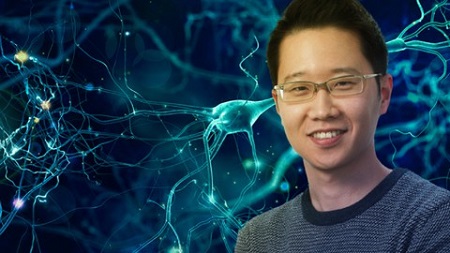
English | MP4 | AVC 1280×720 | AAC 44KHz 2ch | 55 lectures (9h 39m) | 2.29 GB
Get An Intuitive Understanding of Deep Learning
Are you interested in Artificial Intelligence (AI), Machine Learning and Artificial Neural Network?
Are you afraid of getting started with Deep Learning because it sounds too technical?
Have you been watching Deep Learning videos, but still don’t feel like you “get” it?
I’ve been there myself! I don’t have an engineering background. I learned to code on my own. But AI still seemed completely out of reach.
This course was built to save you many months of frustration trying to decipher Deep Learning. After taking this course, you’ll feel ready to tackle more advanced, cutting-edge topics in AI.
In this course:
We assume as little prior knowledge as possible. No engineering or computer science background required (except for basic Python knowledge). You don’t know all the math needed for Deep Learning? That’s OK. We’ll go through them all together – step by step.
We’ll “reinvent” a deep neural network so you’ll have an intimate knowledge of the underlying mechanics. This will make you feel more comfortable with Deep Learning and give you an intuitive feel for the subject.
We’ll also build a basic neural network from scratch in PyTorch and PyTorch Lightning and train an MNIST model for handwritten digit recognition.
After taking this course:
You’ll finally feel you have an “intuitive” understanding of Deep Learning and feel confident expanding your knowledge further.
If you go back to the popular courses you had trouble understanding before (like Andrew Ng’s courses or Jeremy Howards’ Fastai course), you’ll be pleasantly surprised at how much more you can understand.
You’ll be able to understand what experts like Geoffrey Hinton are saying in articles or Andrej Karpathy is saying during Tesla Autonomy Day.
You’ll be well equipped with both practical and theoretical understanding to start exploring more advanced neural network architectures like Convolutional Neural Network (CNN), Recurrent Neural Network (RNN), transformers, etc. and start your journey towards the cutting edge of AI, Supervised and Unsupervised learning, and more.
You can start experimenting with your own AI projects using PyTorch and Supervised Learning
What you’ll learn
- Develop an intuitive understanding of Deep Learning
- Visual and intuitive understanding of core math concepts behind Deep Learning
- Detailed view of how exactly deep neural networks work beneath the hood
- Computational graphs (which libraries like PyTorch and Tensorflow are built on)
- Build neural networks from scratch using PyTorch and PyTorch Lightening
- You’ll be ready to explore the cutting edge of AI and more advanced neural networks like CNNs, RNNs and Transformers
- You’ll be able to understand what deep learning experts are talking about in articles and interviews
- You’ll be able to start experimenting with your own AI projects using PyTorch
Table of Contents
Deep learning – the big picture
1 Introduction
2 What is Machine Learning exactly
3 Different types of machine learning supervised, unsupervised, and reinforcement
4 The big picture
5 Deep neural network as features and weights
6 Loss functions and training vs inference
7 Why deep learning is unintuitive and how to get good at it
8 How to make neural networks feel intuitive
9 Course overview
Reinventing deep neural network from scratch
10 Linear regression and MSE loss
11 Numerical analysis – a.k.a. “trial-and-error”
12 Network view
13 Perceptrons
14 The “Deep” in deep learning
15 Activation Function
16 Overparameterization and overfitting
17 Linear Algebra detour
18 Vectorization (= parallelization)
19 Scalability and emergent properties
20 Recap of the forward pass and brief introduction to backward pass
How the model learns on its own – Back Propagation algorithm deep-div
21 The back propagation algorithm
22 Calculus detour
23 Calculus detour II
24 Gradient descent
25 Calculus detour – partial derivatives and gradient descent
26 Calculus detour – the Chain Rule
27 Calculus detour – the Chain Rule II
28 Computational graph I – forward pass
29 Computational graph II – backward pass
30 Computational graph III – backward pass II
31 Computational graph IV – backward pass III
32 Forward and backward pass recap and wrap up
How to make neural networks work in reality
33 Vanishing gradient problem
34 Vanishing gradient solutions I
35 Vanishing gradient solutions II
36 Stochastic and mini-batch gradient descent
37 Other optimizers I
38 Other optimizers II
39 Hyperparameter tuning strategies
40 Batch normalization
41 Overfitting I – problem and solution overview
42 Overfitting II – regularization and drop out
43 Softmax activation
44 Loss functions
45 Cross entropy loss
Coding deep neural networks in PyTorch and PyTorch Lightning
46 Setting up a coding environment using Anaconda and Jupyter Notebook in Vscode
47 Train an MNIST model from scratch in plain PyTorch I
48 Train an MNIST model from scratch in plain PyTorch II
49 Train an MNIST model from scratch in plain PyTorch III
50 Train an MNIST model from scratch in plain PyTorch IV
51 Train an MNIST model using PyTorch’s nn module I
52 Train an MNIST model using PyTorch’s nn module II
53 Train an MNIST model using PyTorch Lightning I
54 Train an MNIST model using PyTorch Lightning II
55 Next steps
Resolve the captcha to access the links!